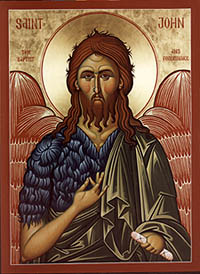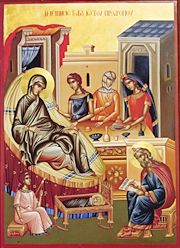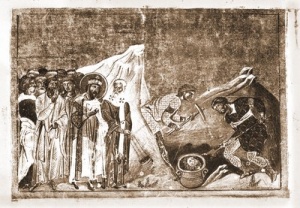John the Forerunner
Isaiah 40:3-5 is commonly read as a prophecy of John. His father, Zacharias, was a priest of the course of Abia (1 Chr. 24:10), and his mother, Elizabeth, was of the daughters of Aaron (Luke 1:5). John held the priesthood of Aaron, giving him the authority to perform baptisms of God.
His birth took place six months before that of Jesus, and according to the Gospel account was expected by prophecy (Matt. 3:3; Isa. 40:3; Mal. 3:1) and foretold by an angel. Zacharias lost his power of speech because of his unbelief over the birth of his son, and had it restored on the occasion of John's circumcision (Luke 1:64).
John was a Nazarite from his birth (Luke 1:15; Num. 6:1-12). He spent his early years in the mountainous tract of Judea lying between Jerusalem and the Dead Sea (Matt. 3:1-12). He led a simple life, wearing rope (gamla) fiber clothing and eating "locusts and wild honey" (Matt. 3:4).
As an adult John started to preach in public, and people from "every quarter" were attracted to his message. The essence of his preaching was the necessity of repentance and turning away from selfish pursuits. He denounced the Sadducees and Pharisees as a "generation of vipers," and warned them not to assume their heritage gave them special privilege (Luke 3:8). He warned tax collectors and soldiers against extortion and plunder. His doctrine and manner of life stirred interest, bringing people from all parts to see him on the banks of the Jordan River. There he baptized thousands unto repentance.
The fame of John reached the ears of Jesus in Nazareth (Matt. 3:5), and he came from Galilee to Jordan to be baptized by John, on the special ground that it became him to "fulfill all righteousness" (Matt. 3:15). John's special office ceased with the baptism of Jesus, who must now "increase" as the King come to his kingdom. He continued, however, for a while to bear testimony to the Messiahship of Jesus. He pointed him out to his disciples, saying, "Behold the Lamb of God." His public ministry was suddenly (after about six months probably) brought to a close by his being cast into prison by Herod, whom he had reproved for the sin of having taken to himself the wife of his brother Philip (Luke 3:19). He was shut up in the castle of Machaerus, a fortress on the southern extremity of Peraea, 9 miles east of the Dead Sea, and here he was beheaded at the instigation of Herodias; later tradition also implicates Salomé. His disciples, having consigned the headless body to the grave, went and told Jesus all that had occurred (Matt. 14:3-12). John's death occurred apparently just before the third Passover of Jesus' ministry.
Jesus himself testified regarding John that he was a "burning and a shining light" (John 5:35). John was the last of the Old Testament prophets, thus serving as a bridge figure between that period of revelation and Jesus. They also embrace a tradition that, following his death, John descended into Hell and there once more preached that Jesus the Messiah was coming.
Contents
Feast days
The Orthodox Church remembers Saint John the Forerunner on six separate feast days, listed here in order of the church year which begins on September 1:
- September 23 - Conception of St. John the Forerunner
- October 12 - The Russian Orthodox Church observes the Transfer of the Right Hand of the Forerunner from Malta to Gatchina (1799).
- January 7 - The Commemoration of St. John the Forerunner (main feast day, immediately after Epiphany on January 6)
- February 24 - First and Second Finding of the Head of St. John the Forerunner
- May 25 - Third Finding of the Head of St. John the Forerunner
- June 24 - Birth of St. John the Forerunner
- August 29 - The Beheading of St. John the Forerunner
Also, St. John's parents Zechariah and Elisabeth, are commemorated on September 5.
Relics
The First Uncovering of the Head of St. John the Baptist took place in the fourth century at the time when Saint Constantine the Great and his mother, St. Helen, began restoring the holy places of Jerusalem.
The Second Finding of the Precious Head of St. John the Baptist of took place on on February 18, 452, at Emesa.
After the Seventh Ecumenical Council (787), which reestablished the veneration of icons, the head of St. John the Baptist was returned to the Byzantine capital in around the year 850. The Church commemorates this event on May 25/June 7 as the Third Finding of the Precious Head of St. John the Baptist.
His relics are kept in several places including:
- St. Demetrios Church, Neo Phaleron, Piraeus
- Benaki Museum, Athens
- Sacred Relics Room, Topkapi Museum, Constantinople (entire right arm and cranium)
- Umayyad Mosque in Damascus, Syria
- Cetinje Monastery, Montenegro (right palm)
See also
External links
- The Baptism of Christ - Uncovering Bethany beyond the Jordan - 47 min Documentary; includes interviews with various Eastern Orthodox representatives, incl. Greek Orthodox Bishop Vindictus of Jordan
- Several Beautiful Icons of St. John the Baptist and Forerunner, mostly by Living American Iconographers
- Translation of the relic of the Right Hand of John the Baptist - OCA Website.
- Priest Maxim Massalitin. The Untold Story of the Head of St. John the Baptist. Pravoslavie.ru (Translation by OrthoChristian.com). 07/03/2012.
Categories > Church History
Categories > Church History
Categories > Church History
Categories > Liturgics > Feasts
Categories > Liturgics > Feasts
Categories > Liturgics > Feasts
Categories > People > Saints
Categories > People > Saints > Biblical Saints
Categories > People > Saints > Saints by century > 1st-century saints


